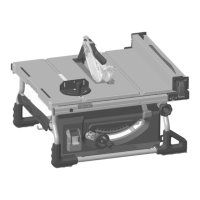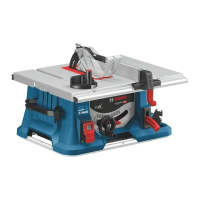-27-
$!%%'&&
CROSSCUTTING is known as cutting wood across
the grain, at 90°, or square with both the edge and
the flat side of the wood. This is done with the miter
gauge set at 90° (Fig. 44).
Make sure blade guard is installed for all “thru-saw-
ing” operations (when sawblade cuts entirely thru
the thickness of the workpiece). Replace guard
IMMEDIATELY after com pletion of dadoing or
rabbeting cuts.
Have blade extend approximately 1/8" above top of
work piece. Additional blade exposure would in-
crease the hazard potential.
Do not stand directly in front of the blade in case of
a THROWBACK (small cut-off piece caught by the
back of the blade and thrown toward the operator).
Stand to either side of the blade.
Keep your hands clear of the blade and out of the
path of the blade.
If blade stalls or stops while cutting, TURN SWITCH
OFF before attempting to free the blade.
Do not reach over or behind the blade to pull the
work piece through the cut … to support long or
heavy workpieces … to remove cut-off pieces of ma-
terial or FOR ANY OTHER REASON.
Do not pick up small pieces of cut-off material from
the table. REMOVE them by pushing them OFF the
table with a long stick. Otherwise they could be
thrown back at you by the rear of the blade.
Do not remove small pieces of cut-off material that
are close to or may become TRAPPED inside the
blade guard while the saw is RUNNING. THIS
COULD ENDANGER YOUR HANDS or cause a
KICKBACK. Turn the saw OFF. After the blade has
stopped turning, lift the guard and remove the piece.
If workpiece is warped, place the CONCAVE side
DOWN. This will help prevent it from rocking while it
is being cut.
The graduations on the miter gauge provide accu-
racy for average woodworking. In some cases
where extreme ac curacy is required, when making
angle cuts, for example, make a trial cut and then
recheck it with an accurate square or protractor.
If necessary, the miter gauge head can be swiveled
slightly to compensate for any inaccuracy.
&" The space between the miter gauge bar and
the groove in the table is held to a minimum during
manu fac turing. For maximum accuracy when using
the miter gauge, always “favor” one side of the
groove in the table. In other words, don’t move the
miter gauge from side to side while cutting but keep
one side of the bar riding against one side of the
groove.
&" Glue a piece of sandpaper to the face of the
miter gauge head. This will help prevent the work-
piece from “creep ing” while it is being cut.
The miter gauge may be used in either of the
grooves in the table. Make sure it is locked.
When using the miter gauge in the LEFT hand
groove, hold the workpiece firmly against gauge
head with your left hand, and grip the lock knob
with your right hand.
When using the RIGHT hand groove, hold the
workpiece with your right hand and the lock knob
with your left hand.
FIG. 44

